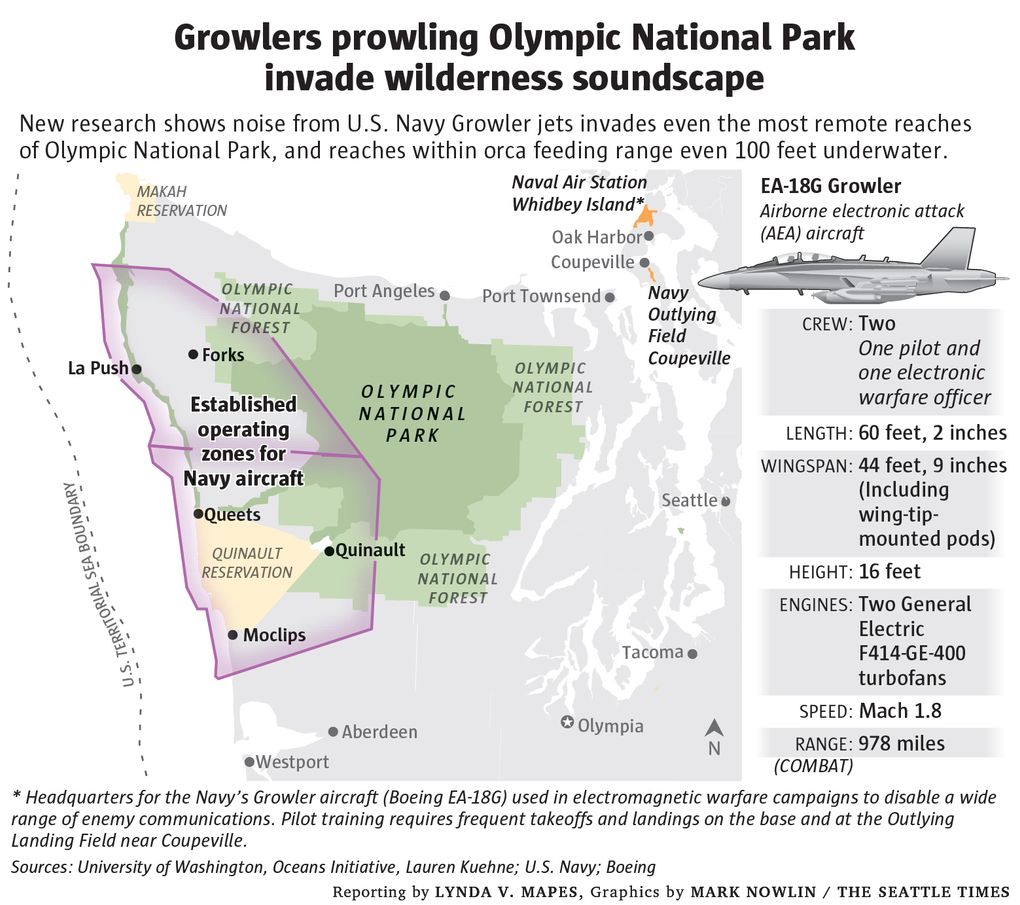On the beaches, in the deepest reaches of the backcountry — even nearly 100 feet underwater — the noise of Navy Growler training jets is unescapable for people and even endangered southern resident orcas, new scientific research shows.
In a paper published in the Journal of Marine Science and Engineering, scientists reported an underwater microphone anchored in nearly 100 feet of water offshore of the runway at Naval Air Station Whidbey Island distinctly picked up the sound of the jets, at levels known to affect orca behavior.
To the orcas at that depth, the noise is about as loud as a cruise ship about 650 feet away, said Rob Williams, lead scientist at the research nonprofit Oceans Initiative, and an author on the paper.
Orcas use sound to hunt, so underwater noise can impair their ability to get enough to eat. Washington state is undertaking a regulatory process now to limit whale watching on southern resident killer whales to reduce the impact of underwater noise on the orcas. Boat noise and interference is one of the three biggest threats scientists have identified so far to the orcas’ survival.
Jet noise underwater? That has not been on the table.
Lauren Kuehne, lead author on the paper, said she was surprised at just how distinct the jet noise was even deep underwater, showing the racket easily penetrates to depths where chinook salmon, the orcas’ primary prey, are often found.
“I was shocked,” said Kuehne, a research scientist and aquatic ecologist at the University of Washington for many years, who now does independent consulting.
“Mentally I was prepared for noise, but I wasn’t prepared for that; it was clear as a bell. It has given me a whole new appreciation; it was very shocking. We are just so deaf. We don’t use our ears the way animals do. For them it is life and death.”
The number and cumulative duration of daily overflights, the team learned, also exceeds those in a majority of studies that have evaluated impacts of noise from military aircraft, worldwide.
Williams said the growler study knocks down the assumption that the noise of the jets doesn’t travel underwater.
“The default [understanding] is the noise is going to bounce off the ocean,” Williams said. “Here we show it doesn’t. The sound propagates underwater. We have shown that it is noisy, and noisy enough to warrant paying attention to.
“If regulators are concerned about boat and vessel noise and disturbance and orcas, I think what we are showing is this ought to be part of the conversation.”
In a second paper, scientists for one year logged the number of flights and volume of noise from Growler jets flying over Olympic National Park.

Scientists used remote recorders to continuously monitor ambient noise at three primary locations on the west side of the Olympic Peninsula between June 2017 and May 2018.
They recorded nearly 5,000 flights over the course of the year at the primary monitoring sites. Of those most (88%) were military flights. During business hours on weekdays, the number of intervals in which military aircraft were audible added up to an average of about an hour or more at each of the locations.
Noise from propeller planes or commercial air traffic was far less frequent, with a total of 5 to 12 minutes of prop noise recorded and less than a minute of commercial aircraft audible for any site during the same period.
The airspace over Olympic is crucial for training, Michael Welding, a spokesperson for the U.S. Navy, wrote in an email. A training site close to home is better for the quality of life for the sailors and saves on fuel and emissions. The airspace also allows for realistic and irreplaceable training exercises, Welding added.
The military averages about 2,300 flights per year over Olympic or 6.3 flights per day when averaged over a full year, he said. An increase is projected over the next several years totaling about 300 additional flights per year by fiscal year 2023, Welding said.
No marine mammal fatalities are predicted to result from training or testing in the area, Welding said, adding that the sound the Growler makes is lower, but not louder than the Prowler jet it replaced.
Loudness was only one aspect of the disturbance caused by the flights. Other important factors for visitors experiencing it — and resident wildlife — is that in a wilderness setting, military jet noise is unexpected, said Kuehne, who also was the lead author on the park noise paper.
Some flyover areas might experience more than 100 events in a single day, the scientists found. Someone on a six-hour hike will likely hear jet noise for close to an hour, interspersed throughout their visit, the authors found.
The paper is part of a growing body of work on the impacts of human-generated noise on protected places. In a 2017 paper, Rachel Buxton, a conservation biologist of Carleton University in Canada, and her co-authors found human-produced noise was double the natural background level in a majority of protected areas in the U.S., and substantially affected critical habitat for endangered species.
The noise levels at times generated by the jets also are high enough to harm human hearing, she noted.
It’s not only the intrusion of an unwanted noise but the loss of the pleasure of natural sounds that are drowned out, said Kurt Fristrup, just retired from the Natural Sounds and Night Skies Division of the National Park Service.
“Even for people who are effective at filtering out the noise, it is still affecting them,” Fristrup said. The stress response from noise is part of what many people come to the national parks to get away from — and adds to a noise burden they often already face at home.
He called both papers “impeccably crafted,” and was concerned about the level of noise documented in what is supposed to be a wilderness park where people come to get away from stressors.
“The fact you as a hiker could experience 100 noise events a day, that is a Grand-Canyon-air-tour level of noise,” Fristrup said.
“If you put up a big tower in a national park, your scenic appreciation would be significantly diminished. The same thing is happening in an auditory sense.”
